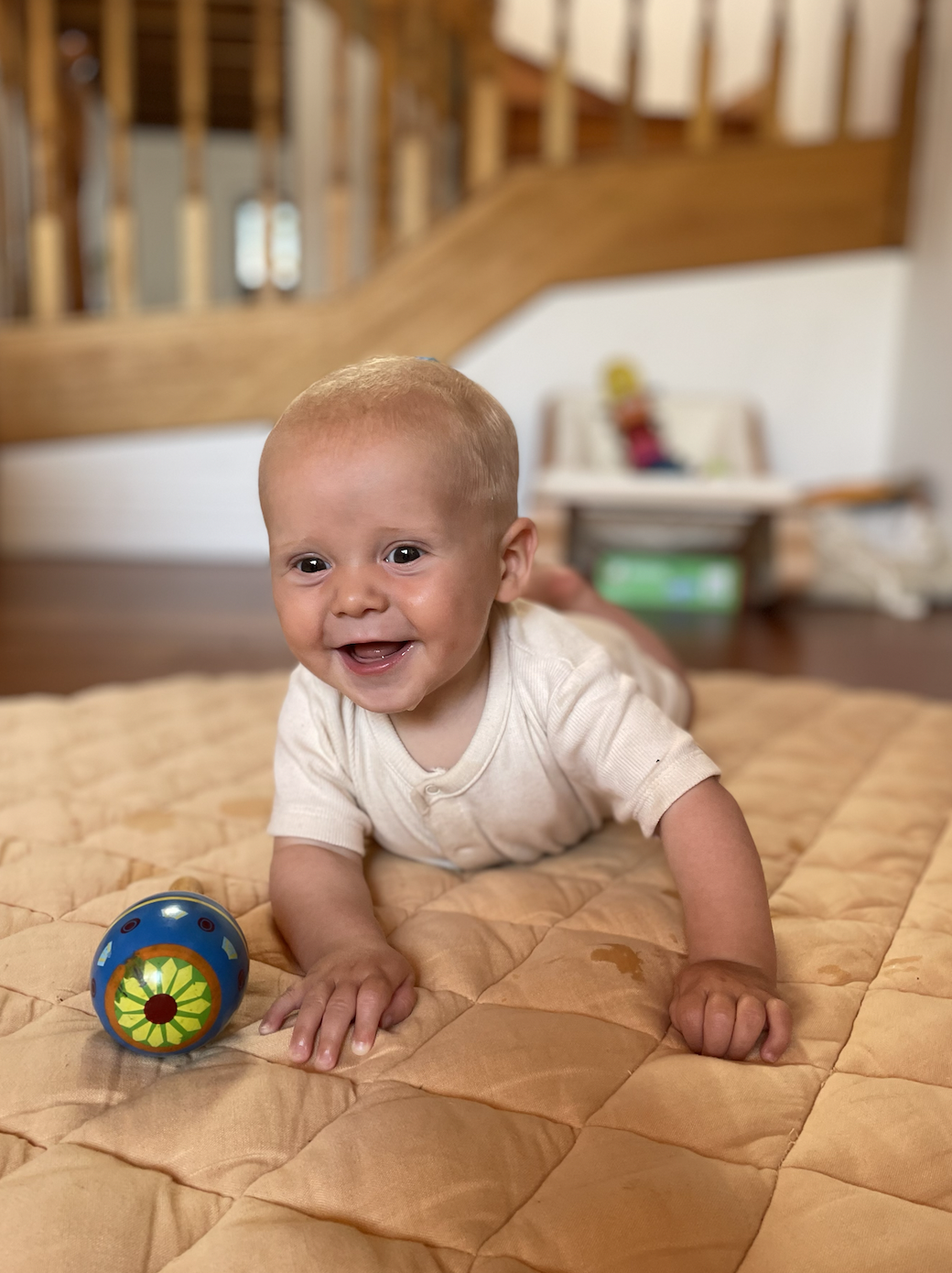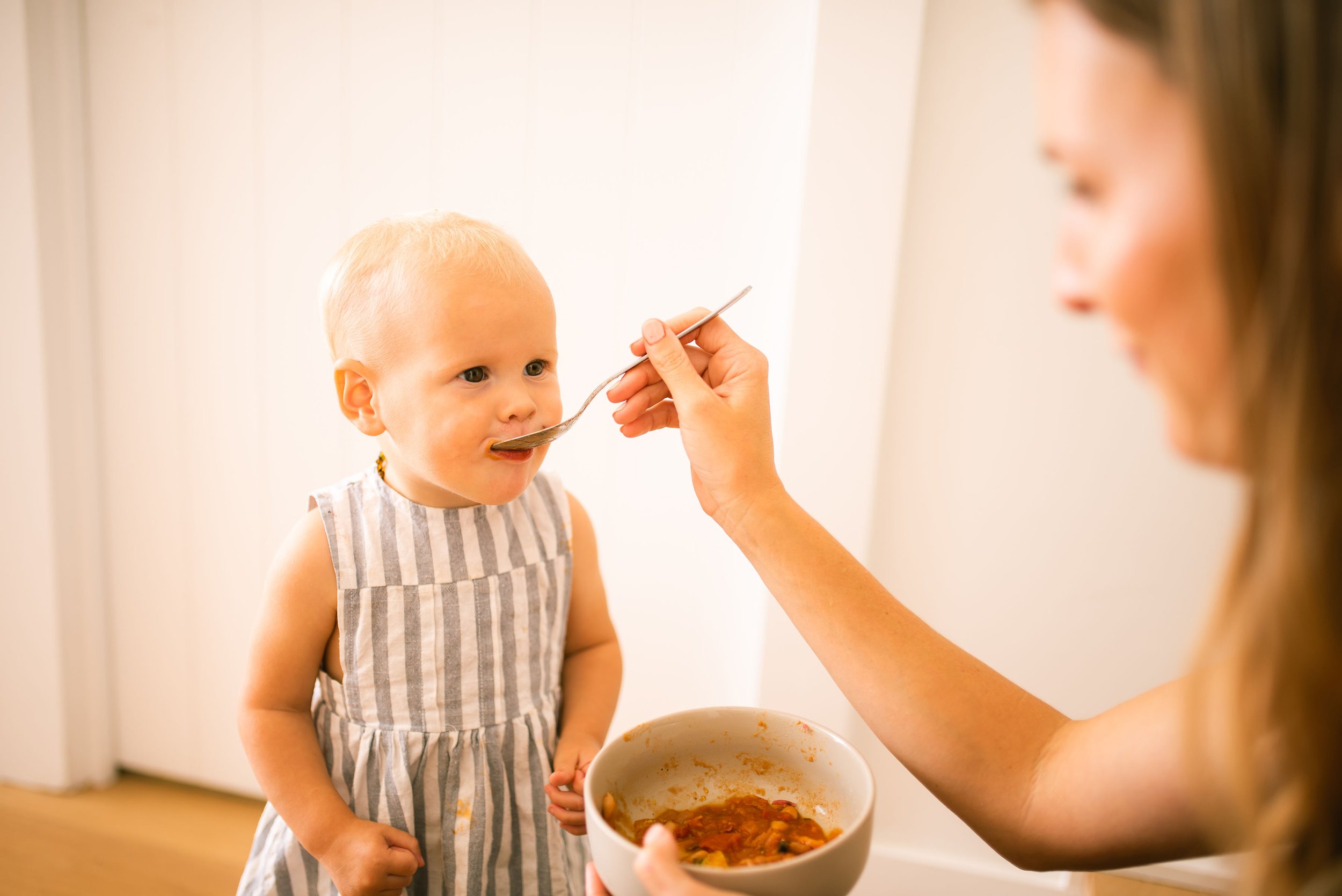Neurodevelopmental signs your baby is ready for solids
As you are heading towards 4 months, you will start to hear comments and well meaning suggestions of starting solids. Even though the guidelines all recommend around 6 months and not before 4 months – the pressure will begin! It’s important to understand the signs of readiness, so you feel confident you are beginning solids at your baby’s pace and not at the expectations of those around you.
Knowing when your baby is ready for solids means you need to navigate signs of food readiness/interest, nutritional needs, gut maturity and recognise neurodevelopmental maturity too. It is easy to identify when a child is interested in food as it is quite obvious (cue grabbing food off your plate or our of your hands!), however, many parents feel unsure about how to recognise the other signs, particularly neurodevelopmental readiness. As your baby moves through the growth and changes from birth to 6 months, there is a beautifully designed pattern of development from the head down to the toes, then central control to peripheral control of limbs that occurs. How a baby moves through these stages provides us insight to neurodevelopment and maturity.
During the early days your baby has uncontrolled jerky movements and involuntary actions that are predictable responses to a particular stimuli. These reflexive responses, known as primitive reflexes, support your baby in the womb, during birth and post birth. You may recognise some of them like the startle reflex, palmar reflex (your baby will grab your finger when placed in their palm), rooting reflex (turning the head to the side of cheek stimulation) and of course the reflexes of the mouth. The mouth reflexes include the suck response and the coordination of swallowing and breathing at the same time, as well as the tongue thrust reflex. All of these primitive reflexes are controlled by the brain stem. The lower, older part of the brain.
As your baby experiences the world around them through their sensory system and they start to enjoy activities like tummy time, their brain matures. Connections are being made in the more mature part of the brain called the cortex. At this time the need for the primitive reflexes decreases, the cortex overrides the brain stem, and your baby can now respond appropriately and consciously to the world around them.
It is during this time that they start to develop their postural reflexes and develop postural tone (trunk stability). Both are key milestones to having the stability, strength and balance needed for starting solids.
Some of the postural/neurodevelopmental signs that your baby is ready for solids includes:
-
Having good neck control
-
The ability to sit up unsupported
-
Ability to maintain balance and strength when bringing both arms to the mouth
-
Able to use a pincer grip (thumb and pointer finger) to pick up food
Understanding Postural Signs
Neck control starts developing in the early weeks of life and continues to develop into a very sophisticated system that responds to feedback from the body and information from the eyes about the environment. Neck control isn’t just about keeping the chin up, it’s about being able to turn, tilt, shake and nod with control and ease.
How to assess Neck Postural Reflexes & Neck Control:
-
Place your baby on your lap in a seated position.
-
Gently tilt them from side to side and see if the head ‘rights’ itself by tilting the opposite way. Your baby should be able to keep their head level to the horizon.
-
Then with a noisy toy, encourage your baby to follow it to the sides, up and down and turning left and right.
Well done, you have just checked the neck righting reflexes and neck range of motion and control. If your baby was able to do all those activities without fatigue or flopping forward, they have wonderful neck control.
Trunk stability comes from the development of postural reflexes and strengthening core tone. With plenty of tummy time, pulling up from lying on their back to seated position (pull-to-sit), rolling and all four rocking, your baby will naturally develop their postural strength and tone. The postural reflexes called propping reflexes are particularly important for learning to sit as they develop around 6 months and help a baby to stop themselves falling forward and to the sides. The posterior propping to prevent falling backwards, doesn’t develop until about 10 months, so it is important that your baby is in a chair with good back support. After some time, your baby won’t need to prop with their arms, their trunk stability will be so sophisticated that they will be able to stay seated upright without using the arms at all! Perfect for when they have both hands full of food at the mouth.
How to assess Postural Reflexes & Seated Trunk Stability:
-
Place your baby in a seated position on the ground while you are holding them around their middle.
-
Gently tilt your baby to the side about 45 degrees and look for the same side arm to ‘prop’ by extending out towards the ground. Check the other side is also present.
-
Then check that your baby can stop falling forward by guiding the trunk forward and watching both arms stop them folding onto their legs.
-
To check for trunk stability, place your baby into a high chair and see if they fall to the sides, flop forward over the tray table, look very rounded or look frightened and unstable. If you notice any difficulty in your baby being able to sit comfortably and be able to move their arms and head without their posture slouching, they may not be ready for solids just yet.
Keep in mind your baby’s chair is particularly important here. Ensure your baby has both feet sitting well on a footrest and the chair has good back support that prevents them falling backwards. If your baby is smaller or your high chair has a large gap between the tray and the back of the seat, using a folded towel and small pillow can be helpful to set up optimal posture. We want your baby’s belly to be nice and close to the tray and no gap behind them. By getting this setup up right, it supports stability, feeling grounded and in control of posture through fun food play.
What is sitting unassisted or independent sitting?
As your baby grows and develops, they will eventually reach the stage where they are ready to start eating solid foods. This is an exciting time for both parents and babies, as it opens a whole new world of flavours and textures for them to explore. However, it’s important to remember that introducing solids is not just about the food itself, but also about the way that babies learn to sit and eat. Understanding how to identify the milestones like independent sitting helps parents feel confident that the timing is right and will also help your baby during the transition to solid foods.
Independent sitting is the ability for a baby to sit up on their own without the assistance of a parent, caregiver or baby gear. This means that when they sit on your lap, they can keep their head and torso upright. When you place them in a high chair, although they may still lean a little in the early weeks they do not flop forward or slouch down making eating solids dangerous.
Independent sitting is a crucial milestone for babies. Sitting leads to a cascade of effects thanks to the opportunity it brings for learning such as exploring objects, learning from seeing more in the environment and socially. When introducing solids, sitting allows babies to be more involved in the feeding process and to explore their food in a more interactive and safe way. When babies are able to sit independently, they have more stability and confidence. They can reach for food, grab it, and bring it to their mouth without falling or slouching. This helps them to focus on learning about different textures, flavours, and temperatures without being uncomfortable and have a fear of falling.
Independent sitting also allows babies to develop their fine motor skills, such as grasping and manipulating objects and increased social information from watching hands and faces from caregivers. As babies learn to hold and eat food, they are developing the muscles in their hands and fingers, which will be important for later on when they start to explore more complex toys and activities. While doing this, they are also interacting with siblings and parents. Watching facial expressions and responses, learning social cues and routines as well as reciprocal communication.
Another important part of independent sitting for babies is the role of the legs and feet, thus the use of a foot rest is ideal. Having the ability to place pressure through the feet supports them using their hamstring in the back of the legs and quadriceps in the thighs. Having a foot rest while sitting in a high chair supports babies to feel grounded, provides more feedback through the legs and helps them stay upright more comfortably for longer.
When your baby is ready to start solid foods, it’s important to provide them with a safe and stable environment to eat in. Choose a highchair or booster seat with good back support, as babies cannot ‘prop’ with their arms to prevent backwards falling until about 10 months of age, they rely on core strength shifting and using their legs to help stay up. Look for a chair that has a foot rest that your baby’s legs can reach even when they are young as many are made only for older children. Your chair should include a tray or the ability to join your family at the dinner table and a five-point harness to help to keep your baby secure while they eat.
Remember that every baby is different and will reach the milestone of independent sitting at their own pace. There are many things that may contribute to later independent sitting. This may include reduced tummy time and floor time in the early months as tummy time, rolling and playing with toys on the floor all contribute to building core strength.
If your baby is moving closer to 5 months old and you feel they are nowhere near independent sitting it’s a great opportunity to support them with the following exercises as a start.
-
Tummy time ball rocking – placing your baby on their belly on an exercise ball. Rock them forward and back, side to side while supporting them. This is one of my favourite exercises for building strength and muscle tone. Do this for a minimum 5 mins a day. But the more you do the better!
-
Sitting ball rocking – place your baby in a seated position on the ball. Support them to ensure they are able to stay as upright as possible. Gently rock their hips side to side and back and forth. Watch them respond by tightening through their abdomen.
-
Pull-to-sit – with your baby lying on the ground on their back, get their attention by cooing and smiling. Slowly pull their arms so they move into a seated position. We want to see both arms bent and chin tucking to know they are activating their core, shoulders, and neck muscles. If their head stays extended right back, this is not an appropriate activity for them.
-
Plenty of floor play. Rolling, tummy time, reaching, side sitting, supported sitting, reaching while sitting etc Babies need hours of floor play and interaction. Often our busy lives means babies miss out on the extended floor play needed. Or perhaps they had reflux or other discomforts that made floor play difficult. Catching up on those lost opportunities will help catch them up!
The above information is appropriate for neurotypical babies born at the expected gestational age. If your baby’s health history is different, please consult with your health care team for individualised expectations and advice.
If you have any concerns about your baby’s progression to independent sitting, speaking with your local chiropractor with specific training in paediatrics or your local paediatric physiotherapist can be really helpful and insightful.
Introducing solids is such a wonderful time for families. By understanding the importance of independent sitting and providing a safe and stable environment for your baby to eat in, you can help your little one to make a smooth transition to solid foods and be part of your family’s meal times.
Written by Dr Jacey Pryjma
Fellow Paediatric Chiropractor AICE 2022
Advanced Paediatric Chiropractor
ACCCP 2022
Owner of Australian Children’s
Chiropractic Centre








+ show comments
- Hide Comments
add a comment